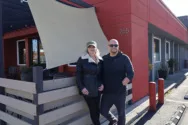
Home » Habitat, DNR explore affordable housing project in Pasco
Habitat, DNR explore affordable housing project in Pasco

Tri-County Partners Habitat for Humanity is assessing whether 16 acres of state land in Pasco, at the intersection of Road 76 and Burden Boulevard and north of Interstate 82, are suitable for a planned development.
Courtesy Franklin County GIS DepartmentFebruary 13, 2025
Tri-County Partners Habitat for Humanity is doing its part to provide affordable housing – and a potential agreement with the state Department of Natural Resources may be a way to offer more of it.
The Richland-based nonprofit and the state agency are assessing whether 16 acres of DNR land in Pasco, at the intersection of Road 76 and Burden Boulevard, are suitable for a planned development.
If so, it could mean 150 to 250 new townhouses, duplexes and triplex units for qualifying low-income families.
Habitat for Humanity works to create affordable housing, with homeowners helping build their own houses in the process.
Thanks to legislation passed in 2024 intended to incentivize affordable housing on public lands, Habitat is working with the Department of Natural Resources to build on its residential lands.
House Bill 2003 created a tax exemption when public lands are leased for affordable housing for low- and moderate-income households.
The bill helped make these lands “income-generating for the state, as well as put some solid teeth behind solutions for our housing crisis,” said Jet Richardson, executive director of Tri-County Partners Habitat for Humanity.
The local Habitat branch would be one of the first in the state to work with DNR on a project like this, he said.
Pasco property
The Habitat-DNR feasibility study will look at the cost of infrastructure, the site layout, the cost to build each unit and requirements for green space.
If that goes well, the next step would be a formal lease agreement for at least 100 years, Richardson said.
He hopes the feasibility study will take as little as a year and that the nonprofit could break ground on the project in two years.
Because this project would be built on DNR land, several aspects will look a little different than Habitat’s typical projects if an agreement is reached, including a different housing style.
“As we move into this opportunity with Department of Natural Resources, the type of homes that we are building will have to change, meaning we’ll be doing more townhome style, multifamily style housing, multilevel housing,” Richardson said.
“The Tri-Cities has done really well with single-family detached for a long, long time,” he said. “But as the cities grow and maximize their borders, they have to look at densifying their cores.”
Typically, Habitat units take about seven to eight months to build, Richardson said, but that’s with known plans. With new housing plans, it’s not yet clear how long it would take to build each unit.
Land-lease strategy
The way land is handled would shift as well.
Instead of selling a house and the land it’s on, Habitat would use a model similar to community land trusts (CLTs).
Because land is an expensive part of buying a home, CLTs “sell the structure on the ground to qualifying families or individuals and the land is leased separately at a reduced rate in order to keep the cost of the housing affordable,” Richardson said.
Although other affiliates around the state have used this model, it would be a first for Habitat and it is still figuring out what it will look like, Richardson said.
This won’t necessarily be the model Habitat uses for all future homebuilding projects, but it’s an important option to address the housing crisis, he said.
“Usually when people buy homes, and the preference is still this way, you want to buy the land, you want to buy the full package,” he said. “But when our market is unaffordable for low-income buyers, then we need to come up with new solutions.”

Hundreds of affordable housing units could be built on state Department of Natural Resources land in Pasco through Tri-County Partners Habitat for Humanity. Former commissioner of public lands Hilary Franz, left, toured the 16-acre DNR site in December. Tri-County Partners Habitat for Humanity executive director Jet Richardson is on the right.
| Courtesy Tri-County Partners Habitat for HumanityIncome brackets
Building on DNR land also allows more people to buy Habitat homes.
Because of grant restrictions, Habitat is required to work with families or individuals earning below 80% of the area’s median income.
Typically, that means Habitat works within the range of 30% to 80% of the area median income, but because of the current market, it’s difficult to work with anyone earning below 50% area median income.
“It’s really important that we not sell a home to someone who’s not ready and can’t afford it,” Richardson said.
With the land kept out of the price of the houses, it will be easier for Habitat to work with those at the lower end of range. And because the state bill defines moderate-income households above 80% and below 115% of median family income, Habitat can now work with households at the higher end of the range.
“That’ll be really wonderful, because that is the segment of the population, I think, that is really priced out the most from anything that is affordable, and they are the ones that are probably the most buyer-ready,” Richardson said.
Habitat buyers
Being buyer-ready is important to Habitat’s work. Richardson described the rental industry as having a bottleneck when communities are fast-growing and housing is unaffordable.
“If we can move renters who are buyer-ready into ownership opportunities, then that ... creates vacancies in the rental market for people coming behind them,” he said.
It’s important to note that Habitat doesn’t give away its houses for free: families have to qualify to buy a home based on income, credit scores, work history and stability.
“Our families are incredibly hard working, and they are among the most deserving of this opportunity to enter into this home ownership style of living. They’re looking at long-term stability for their children. They aren’t looking to flip a house and make a quick buck,” Richardson said.
There isn’t a waitlist to get a home, either. That might put people in a position of turning down a promotion or other opportunity to try to maintain eligibility, Richardson said.
Once Habitat knows how many homes will be in a project, they open the application for that number of homes and make selections on a first-come, first-served basis.
Then, those families will put in the work to build their homes and their neighbors’ homes. Through the process, they learn how to maintain their homes and form a community with their neighbors.
When they’re ready to move in, they’ll already know those living nearby and can help and support each other.
Latest News Real Estate & Construction Local News Charitable Giving & Nonprofits
KEYWORDS February 2025
Related Articles
Related Products





